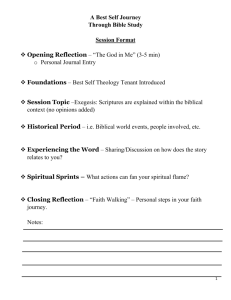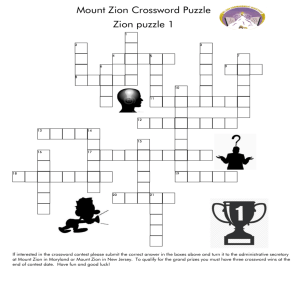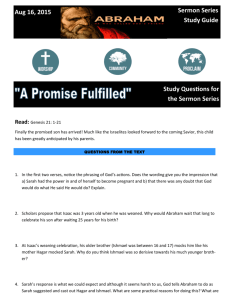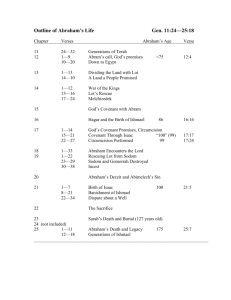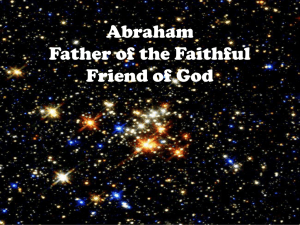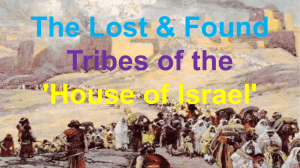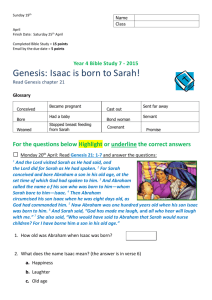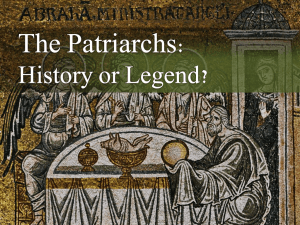Source Essay: Genesis 20-23 The authorship of the bible is often
advertisement
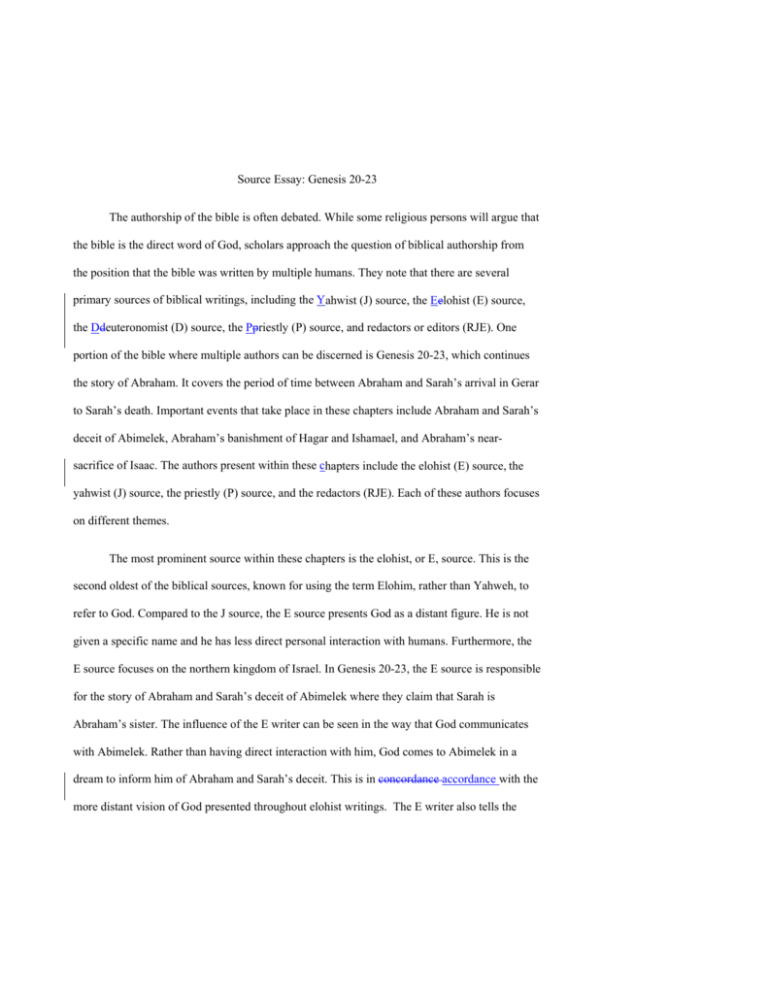
Source Essay: Genesis 20-23 The authorship of the bible is often debated. While some religious persons will argue that the bible is the direct word of God, scholars approach the question of biblical authorship from the position that the bible was written by multiple humans. They note that there are several primary sources of biblical writings, including the Yahwist (J) source, the Eelohist (E) source, the Ddeuteronomist (D) source, the Ppriestly (P) source, and redactors or editors (RJE). One portion of the bible where multiple authors can be discerned is Genesis 20-23, which continues the story of Abraham. It covers the period of time between Abraham and Sarah’s arrival in Gerar to Sarah’s death. Important events that take place in these chapters include Abraham and Sarah’s deceit of Abimelek, Abraham’s banishment of Hagar and Ishamael, and Abraham’s nearsacrifice of Isaac. The authors present within these chapters include the elohist (E) source, the yahwist (J) source, the priestly (P) source, and the redactors (RJE). Each of these authors focuses on different themes. The most prominent source within these chapters is the elohist, or E, source. This is the second oldest of the biblical sources, known for using the term Elohim, rather than Yahweh, to refer to God. Compared to the J source, the E source presents God as a distant figure. He is not given a specific name and he has less direct personal interaction with humans. Furthermore, the E source focuses on the northern kingdom of Israel. In Genesis 20-23, the E source is responsible for the story of Abraham and Sarah’s deceit of Abimelek where they claim that Sarah is Abraham’s sister. The influence of the E writer can be seen in the way that God communicates with Abimelek. Rather than having direct interaction with him, God comes to Abimelek in a dream to inform him of Abraham and Sarah’s deceit. This is in concordance accordance with the more distant vision of God presented throughout elohist writings. The E writer also tells the story in Genesis 21 of Abraham’s banishment of Hagar and his son Ishmael, and God’s promise to Abraham and Hagar that Ishmael will become a great nation. Once again, God is presented as less anthropomorphic within this narrative than he is within J writings. He uses an angel as an intermediary to communicate with Hagar rather than appearing in a physical form or speaking directly to her. Both the story of Abraham’s deceit of Abimelek and the story of Hagar and Ishmael’s banishment are characteristic of the E writer in that they deal with familial conflict rather than human history, which is a primary concern of the J writer. The story of Abraham’s near sacrifice of Isaac in Genesis 22 is also told primarily through the E writer. The portion of this story where Isaac is saved, however, is not written by the E writer. This source does not mention Isaac again, and leads the reader to believe that Isaac was sacrificed. It is likely that the E writer chooses to include this narrative because child sacrifice was prevalent within the cultural and religious traditions from which E was writing. The J source is also used in Genesis 20-23. The J, or Yahwist, source is the oldest of the biblical sources. The J source is known for referring to God by the name Yahweh, rather than the term El or Elohim used by the E source up until Exodus. Yahweh, in the J writings, is also more anthropomorphic, having direct and physical contact with humans. The J source includes a detailed account of human history, beginning with the creation story. This characteristic is present in Genesis 22, when the J writer provides an account of the lineage of Abraham’s brother, Nahor. The only other verses by the J writer in Genesis 20-23 occur in Genesis 21, when reference is made to Sarah giving birth to Isaac. This also falls into the characteristic of describing history and lineage. The priestly, or P, source is also present in Genesis 20-23. The priestly writers were writing after the Babylonian exile and strove to preserve and change the religious traditions of Israel. Primary focuses of the P source include legal codes, rituals, purity laws, and genealogies. In Genesis 21, when Isaac’s birth is described, the P writer inserts the detail that Isaac was circumcised when he was eight days old. This is in concordance with the P writers’ focus on rituals and purity laws. According to the laws of God, infants were to be circumcised. Therefore, the P writers include this detail in keeping with their goal of preserving and introducing religious traditions. Another example of this is in Genesis 23. This chapter describes Sarah’s death and Abraham’s attempt to secure a burial place for her. Abraham asks the Hittites for a cave in which he may bury Sarah. Ephron, the owner of the cave, offers to give the cave to Abraham, but Abraham insists upon paying, so he pays four hundred shekels of silver and buries Sarah in the cave. The P writers likely included this story as a further attempt to include religious rituals and laws. A respect for the dead and proper burial is displayed by the Hittites in their willingness to provide Abraham with a place to bury Sarah. Comment [ 1]: Yes. P also wants to emphasize that Abraham had legal claim to this part of Canaan, a part obviously in dispute post‐exile. The redactor also plays an important role in Genesis 20-23. The redactor is an editor of biblical texts. In Genesis 22, when Abraham is on the verge of sacrificing Isaac, the redactor includes an interjection by an angel of Yahweh who stops the sacrifice from taking place. The E source, which composed the rest of the narrative, did not include such an interjection. They never again mention Isaac and it is to be believed that Isaac was sacrificed. The J source, on the other hand, does not include the story of Isaac’s near-sacrifice at all, but mentions Isaac in later chapters. Therefore, the redactor included this portion of Genesis 22 in order to resolve the contradictions between the two major sources. The differing characteristics found in specific segments of Genesis 20-23, show that the bible was almost certainly written by multiple human authors. The passages from the E source include themes of personal conflict and characterize God as a distant being called Elohim. The Comment [ 2]: Yes. Also, RJE tries to emphasize that God does not like human sacrifice, a prohibition perhaps not in effect in ancient northern Israel. passages from the J source focus on human history and lineage and include an anthropomorphic characterization of God, called Yahweh. The P source focuses on religious laws and rituals. Finally, the redactor patches up contradictions between the other sources.
